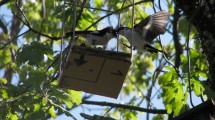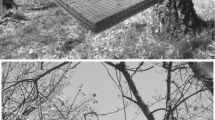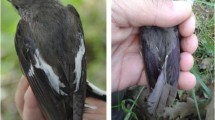Summary
Female Red-winged Blackbirds (Agelaius phoeniceus) are often aggressive towards conspecific females during the breeding season. We hypothesize that the function of female-female aggression in this species is to guard the nonshareable portion of the male's parental investment.
The investment-guarding hypothesis predicts that a female should be more aggressive toward another female evincing interest in mating with the territory-owning male than toward a female simply perching within the male's territory. Results of mount presentations to females with active nests confirmed this prediction. Nesting females attacked a stuffed conspecific female mounted in a precopulatory, ‘soliciting’ posture significantly more often than a mount in a normal, perched posture.
The male's nonshereable parental care consists of provisioning his young, and most of this care is invested in the brood of his primary (first-to-nest) female. It is therefore predicted that primary females should be more aggressive than secondary (later-nesting) females. Female mount presentations also confirmed this prediction. Primary females attacked the soliciting mount significantly more often than secondary females.
Similar content being viewed by others
References
Beecher MD, Beecher IM (1979) Sociobiology of bank swallows: reproductive strategy of the male. Science 205:1282–1285
Birkhead TR (1979) Mate guarding in the magpie (Pica pica). Anim Behav 27:866–874
Crawford RD (1977) Breeding biology of year-old and older female Red-winged and Yellow-headed Blackbirds. Wilson Bull 89:73–80
Dufty AM (1981) Social organization of the Brown-headed Cowbird, Molothrus ater, in New York State. PhD dissertation, State University of New York, Binghamton, New York
Morton ES, Geitgey MS, McGrath S (1978) On bluebird “responses to apparent female adultery.” Am Nat 112:968–971
Nero RW (1956) A behavior study of the Red-winged Blackbird. I. Mating and nesting activities. Wilson Bull 68:4–37
O'Connor E (1976) Response of female Red-winged and Brewer's Blackbirds to the presence of intruding female conspecifics near their nests. MS dissertation, University of Washington, Seattle, Washington
Orians GH (1961) The ecology of blackbird (Agelaius) social systems. Ecol Monogr 31:285–312
Orians GH (1980) Some adaptations of marsh-nesting blackbirds. Princeton University Press, Princton, New Jersey
Orians GH, Christman GM (1968) A comparative study of the behavior of Red-winged, Tricolored, and Yellow-headed Blackbirds. Univ Calif Publ Zool 84:1–85
Patterson CB (1979) Relative parental investment in the Redwinged Blackbird. PhD dissertation, Indiana University, Bloomington, Irdiana
Picman J (1980) Impact of marsh wrens on reproductive strategy of Red-winged Blackbirds. Can J Zool 58:337–350
Power HW, Donor GP (1980) Experiments in cuckoldry in the mountain bluebird. Am Nat 116:689–704
Searcy WA (1979) Female choice of mates: a general model for birds and its application to red-winged blackbirds (Agelius phoiniceus). Am Nat 114:77–100
Sokal RR, Rohlf FJ (1968) Biometry. Freeman, San Francisco, California
Trivers RL (1972) Parental investment and sexual selection. In: Campbell BG (ed) Sexual selection and the descent of man 1871–1971. Aldine, Chicago, Illinois
Yasukawa K, Searcy WA (1981) Nesting synchrony and dispersion in Red-winged Blackbirds: is the harem competitive or cooperative? Auk 98:659–668
Zenone PG, Sims ME, Erickson CJ (1979) Male ring dove behavior and the defense of genetic paternity. Am Nat 114:615–626
Author information
Authors and Affiliations
Rights and permissions
About this article
Cite this article
Yasukawa, K., Searcy, W.A. Aggression in female Red-Winged Blackbirds: A strategy to ensure male parental investment. Behav Ecol Sociobiol 11, 13–17 (1982). https://doi.org/10.1007/BF00297660
Received:
Accepted:
Issue Date:
DOI: https://doi.org/10.1007/BF00297660




